Health Law Assignment: Gillick Competence and Treatment Refusal
VerifiedAdded on 2022/11/30
|10
|2599
|176
Essay
AI Summary
This essay delves into the complexities of health law, specifically focusing on the concept of Gillick competence and its implications for children's rights in medical treatment decisions. The essay begins by outlining the basis for assessing Gillick competence, emphasizing the child's ability to understand the nature of their illness, the proposed treatments, and the associated risks and benefits. It then examines the legal and ethical arguments surrounding the overriding of a Gillick-competent child's refusal of medical treatment. The analysis includes a discussion of relevant case studies and explores scenarios where ethical considerations, such as preserving life, disclosing medical errors, patient's condition, family affairs, pain, panic, and depression, may justify overriding a child's decision. The essay investigates whether legal and ethical arguments can be separated, highlighting the interplay between legal frameworks and moral principles in determining the best course of action for a child's health and well-being. The essay emphasizes the importance of balancing a child's autonomy with the responsibilities of healthcare professionals and the potential influence of various factors, such as family dynamics and the child's emotional state, on their decision-making process.
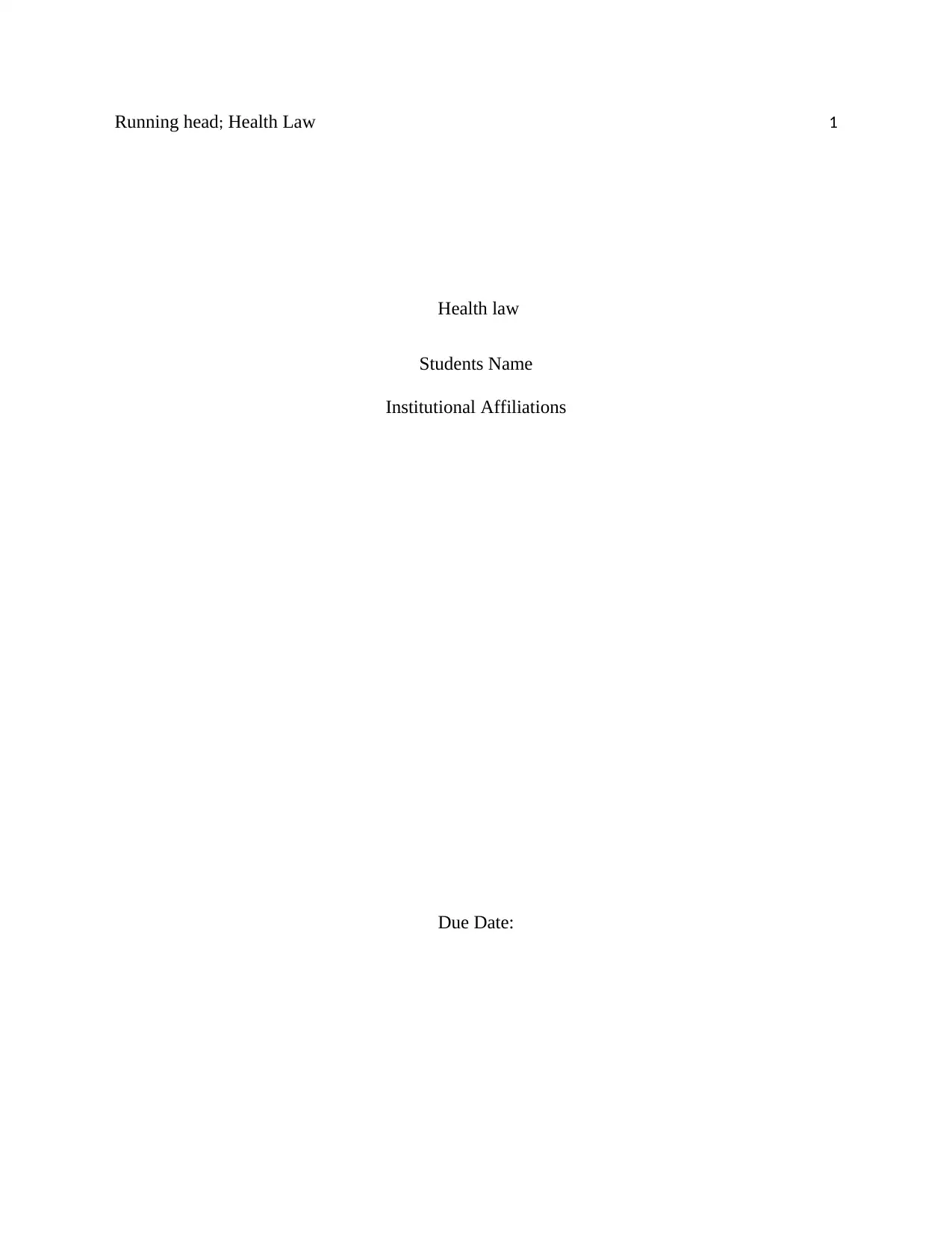
Running head; Health Law 1
Health law
Students Name
Institutional Affiliations
Due Date:
Health law
Students Name
Institutional Affiliations
Due Date:
Paraphrase This Document
Need a fresh take? Get an instant paraphrase of this document with our AI Paraphraser
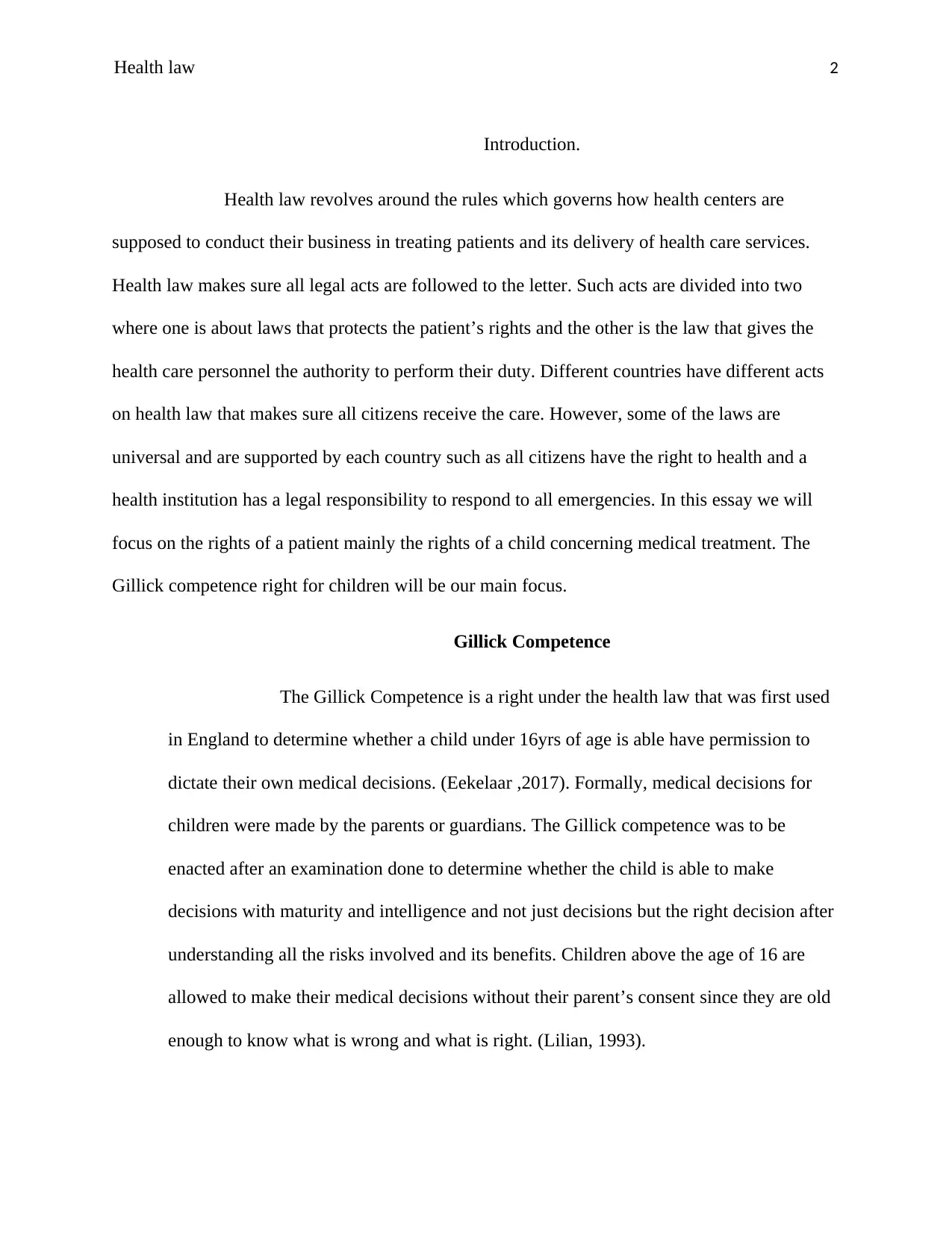
Health law 2
Introduction.
Health law revolves around the rules which governs how health centers are
supposed to conduct their business in treating patients and its delivery of health care services.
Health law makes sure all legal acts are followed to the letter. Such acts are divided into two
where one is about laws that protects the patient’s rights and the other is the law that gives the
health care personnel the authority to perform their duty. Different countries have different acts
on health law that makes sure all citizens receive the care. However, some of the laws are
universal and are supported by each country such as all citizens have the right to health and a
health institution has a legal responsibility to respond to all emergencies. In this essay we will
focus on the rights of a patient mainly the rights of a child concerning medical treatment. The
Gillick competence right for children will be our main focus.
Gillick Competence
The Gillick Competence is a right under the health law that was first used
in England to determine whether a child under 16yrs of age is able have permission to
dictate their own medical decisions. (Eekelaar ,2017). Formally, medical decisions for
children were made by the parents or guardians. The Gillick competence was to be
enacted after an examination done to determine whether the child is able to make
decisions with maturity and intelligence and not just decisions but the right decision after
understanding all the risks involved and its benefits. Children above the age of 16 are
allowed to make their medical decisions without their parent’s consent since they are old
enough to know what is wrong and what is right. (Lilian, 1993).
Introduction.
Health law revolves around the rules which governs how health centers are
supposed to conduct their business in treating patients and its delivery of health care services.
Health law makes sure all legal acts are followed to the letter. Such acts are divided into two
where one is about laws that protects the patient’s rights and the other is the law that gives the
health care personnel the authority to perform their duty. Different countries have different acts
on health law that makes sure all citizens receive the care. However, some of the laws are
universal and are supported by each country such as all citizens have the right to health and a
health institution has a legal responsibility to respond to all emergencies. In this essay we will
focus on the rights of a patient mainly the rights of a child concerning medical treatment. The
Gillick competence right for children will be our main focus.
Gillick Competence
The Gillick Competence is a right under the health law that was first used
in England to determine whether a child under 16yrs of age is able have permission to
dictate their own medical decisions. (Eekelaar ,2017). Formally, medical decisions for
children were made by the parents or guardians. The Gillick competence was to be
enacted after an examination done to determine whether the child is able to make
decisions with maturity and intelligence and not just decisions but the right decision after
understanding all the risks involved and its benefits. Children above the age of 16 are
allowed to make their medical decisions without their parent’s consent since they are old
enough to know what is wrong and what is right. (Lilian, 1993).
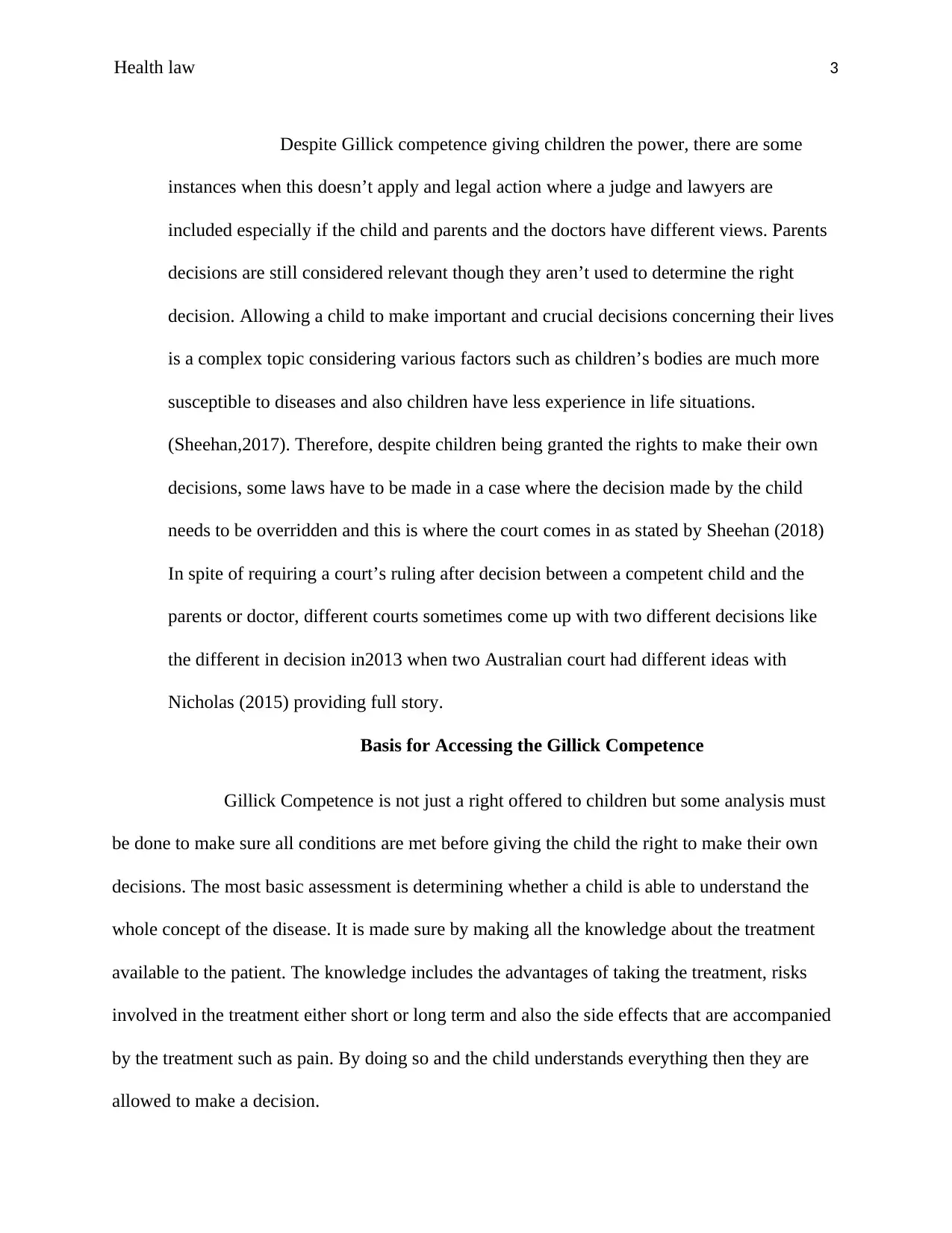
Health law 3
Despite Gillick competence giving children the power, there are some
instances when this doesn’t apply and legal action where a judge and lawyers are
included especially if the child and parents and the doctors have different views. Parents
decisions are still considered relevant though they aren’t used to determine the right
decision. Allowing a child to make important and crucial decisions concerning their lives
is a complex topic considering various factors such as children’s bodies are much more
susceptible to diseases and also children have less experience in life situations.
(Sheehan,2017). Therefore, despite children being granted the rights to make their own
decisions, some laws have to be made in a case where the decision made by the child
needs to be overridden and this is where the court comes in as stated by Sheehan (2018)
In spite of requiring a court’s ruling after decision between a competent child and the
parents or doctor, different courts sometimes come up with two different decisions like
the different in decision in2013 when two Australian court had different ideas with
Nicholas (2015) providing full story.
Basis for Accessing the Gillick Competence
Gillick Competence is not just a right offered to children but some analysis must
be done to make sure all conditions are met before giving the child the right to make their own
decisions. The most basic assessment is determining whether a child is able to understand the
whole concept of the disease. It is made sure by making all the knowledge about the treatment
available to the patient. The knowledge includes the advantages of taking the treatment, risks
involved in the treatment either short or long term and also the side effects that are accompanied
by the treatment such as pain. By doing so and the child understands everything then they are
allowed to make a decision.
Despite Gillick competence giving children the power, there are some
instances when this doesn’t apply and legal action where a judge and lawyers are
included especially if the child and parents and the doctors have different views. Parents
decisions are still considered relevant though they aren’t used to determine the right
decision. Allowing a child to make important and crucial decisions concerning their lives
is a complex topic considering various factors such as children’s bodies are much more
susceptible to diseases and also children have less experience in life situations.
(Sheehan,2017). Therefore, despite children being granted the rights to make their own
decisions, some laws have to be made in a case where the decision made by the child
needs to be overridden and this is where the court comes in as stated by Sheehan (2018)
In spite of requiring a court’s ruling after decision between a competent child and the
parents or doctor, different courts sometimes come up with two different decisions like
the different in decision in2013 when two Australian court had different ideas with
Nicholas (2015) providing full story.
Basis for Accessing the Gillick Competence
Gillick Competence is not just a right offered to children but some analysis must
be done to make sure all conditions are met before giving the child the right to make their own
decisions. The most basic assessment is determining whether a child is able to understand the
whole concept of the disease. It is made sure by making all the knowledge about the treatment
available to the patient. The knowledge includes the advantages of taking the treatment, risks
involved in the treatment either short or long term and also the side effects that are accompanied
by the treatment such as pain. By doing so and the child understands everything then they are
allowed to make a decision.
⊘ This is a preview!⊘
Do you want full access?
Subscribe today to unlock all pages.

Trusted by 1+ million students worldwide
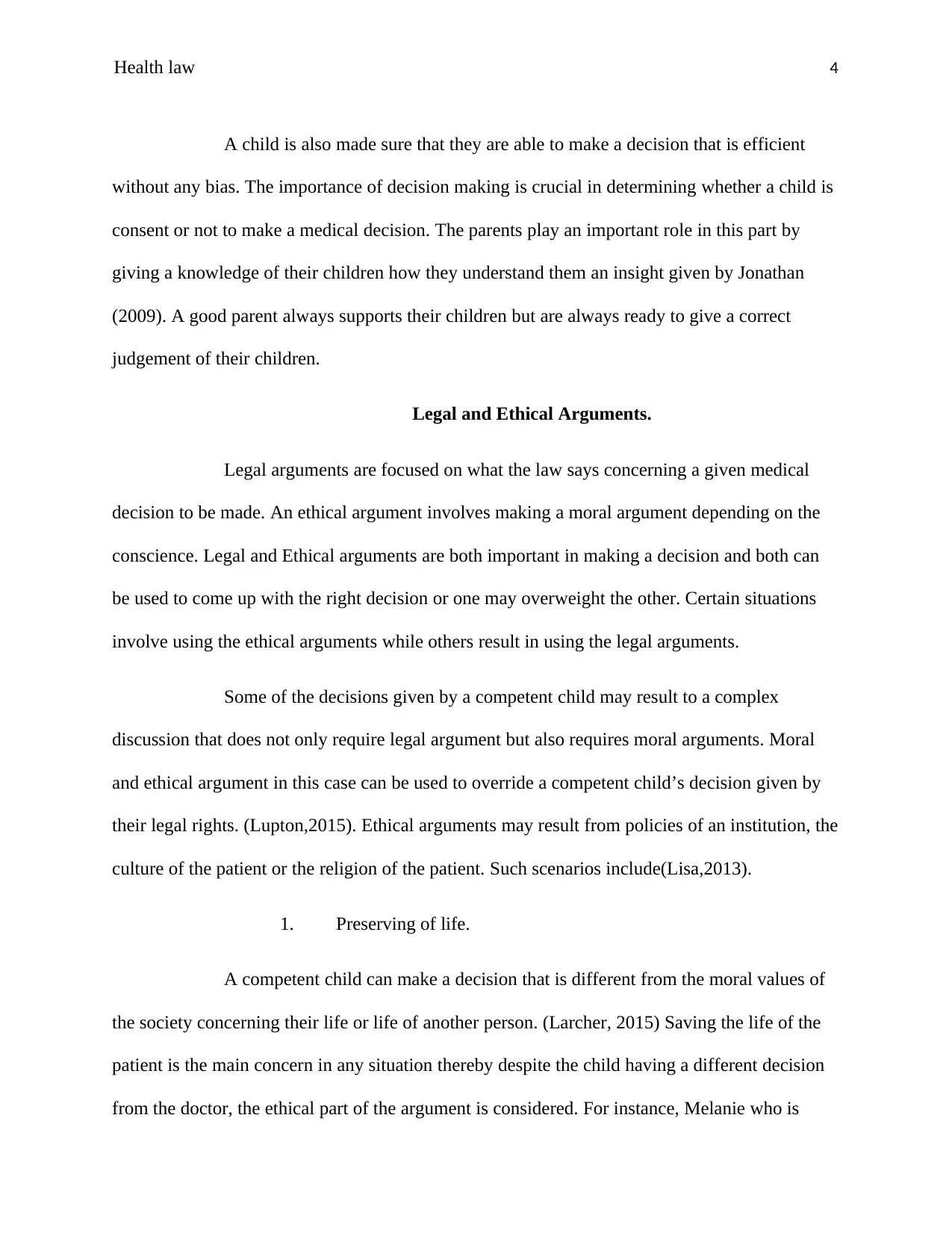
Health law 4
A child is also made sure that they are able to make a decision that is efficient
without any bias. The importance of decision making is crucial in determining whether a child is
consent or not to make a medical decision. The parents play an important role in this part by
giving a knowledge of their children how they understand them an insight given by Jonathan
(2009). A good parent always supports their children but are always ready to give a correct
judgement of their children.
Legal and Ethical Arguments.
Legal arguments are focused on what the law says concerning a given medical
decision to be made. An ethical argument involves making a moral argument depending on the
conscience. Legal and Ethical arguments are both important in making a decision and both can
be used to come up with the right decision or one may overweight the other. Certain situations
involve using the ethical arguments while others result in using the legal arguments.
Some of the decisions given by a competent child may result to a complex
discussion that does not only require legal argument but also requires moral arguments. Moral
and ethical argument in this case can be used to override a competent child’s decision given by
their legal rights. (Lupton,2015). Ethical arguments may result from policies of an institution, the
culture of the patient or the religion of the patient. Such scenarios include(Lisa,2013).
1. Preserving of life.
A competent child can make a decision that is different from the moral values of
the society concerning their life or life of another person. (Larcher, 2015) Saving the life of the
patient is the main concern in any situation thereby despite the child having a different decision
from the doctor, the ethical part of the argument is considered. For instance, Melanie who is
A child is also made sure that they are able to make a decision that is efficient
without any bias. The importance of decision making is crucial in determining whether a child is
consent or not to make a medical decision. The parents play an important role in this part by
giving a knowledge of their children how they understand them an insight given by Jonathan
(2009). A good parent always supports their children but are always ready to give a correct
judgement of their children.
Legal and Ethical Arguments.
Legal arguments are focused on what the law says concerning a given medical
decision to be made. An ethical argument involves making a moral argument depending on the
conscience. Legal and Ethical arguments are both important in making a decision and both can
be used to come up with the right decision or one may overweight the other. Certain situations
involve using the ethical arguments while others result in using the legal arguments.
Some of the decisions given by a competent child may result to a complex
discussion that does not only require legal argument but also requires moral arguments. Moral
and ethical argument in this case can be used to override a competent child’s decision given by
their legal rights. (Lupton,2015). Ethical arguments may result from policies of an institution, the
culture of the patient or the religion of the patient. Such scenarios include(Lisa,2013).
1. Preserving of life.
A competent child can make a decision that is different from the moral values of
the society concerning their life or life of another person. (Larcher, 2015) Saving the life of the
patient is the main concern in any situation thereby despite the child having a different decision
from the doctor, the ethical part of the argument is considered. For instance, Melanie who is
Paraphrase This Document
Need a fresh take? Get an instant paraphrase of this document with our AI Paraphraser
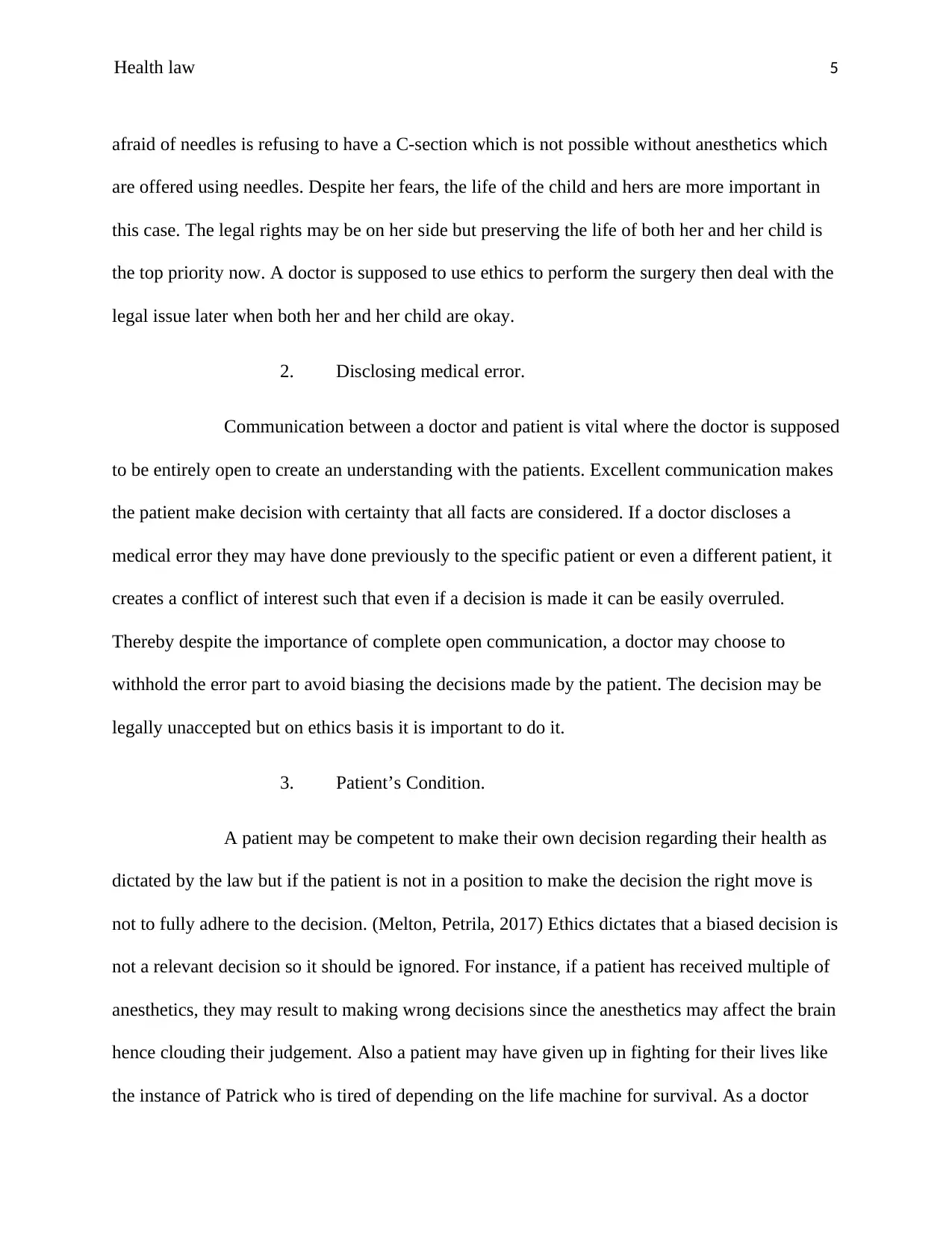
Health law 5
afraid of needles is refusing to have a C-section which is not possible without anesthetics which
are offered using needles. Despite her fears, the life of the child and hers are more important in
this case. The legal rights may be on her side but preserving the life of both her and her child is
the top priority now. A doctor is supposed to use ethics to perform the surgery then deal with the
legal issue later when both her and her child are okay.
2. Disclosing medical error.
Communication between a doctor and patient is vital where the doctor is supposed
to be entirely open to create an understanding with the patients. Excellent communication makes
the patient make decision with certainty that all facts are considered. If a doctor discloses a
medical error they may have done previously to the specific patient or even a different patient, it
creates a conflict of interest such that even if a decision is made it can be easily overruled.
Thereby despite the importance of complete open communication, a doctor may choose to
withhold the error part to avoid biasing the decisions made by the patient. The decision may be
legally unaccepted but on ethics basis it is important to do it.
3. Patient’s Condition.
A patient may be competent to make their own decision regarding their health as
dictated by the law but if the patient is not in a position to make the decision the right move is
not to fully adhere to the decision. (Melton, Petrila, 2017) Ethics dictates that a biased decision is
not a relevant decision so it should be ignored. For instance, if a patient has received multiple of
anesthetics, they may result to making wrong decisions since the anesthetics may affect the brain
hence clouding their judgement. Also a patient may have given up in fighting for their lives like
the instance of Patrick who is tired of depending on the life machine for survival. As a doctor
afraid of needles is refusing to have a C-section which is not possible without anesthetics which
are offered using needles. Despite her fears, the life of the child and hers are more important in
this case. The legal rights may be on her side but preserving the life of both her and her child is
the top priority now. A doctor is supposed to use ethics to perform the surgery then deal with the
legal issue later when both her and her child are okay.
2. Disclosing medical error.
Communication between a doctor and patient is vital where the doctor is supposed
to be entirely open to create an understanding with the patients. Excellent communication makes
the patient make decision with certainty that all facts are considered. If a doctor discloses a
medical error they may have done previously to the specific patient or even a different patient, it
creates a conflict of interest such that even if a decision is made it can be easily overruled.
Thereby despite the importance of complete open communication, a doctor may choose to
withhold the error part to avoid biasing the decisions made by the patient. The decision may be
legally unaccepted but on ethics basis it is important to do it.
3. Patient’s Condition.
A patient may be competent to make their own decision regarding their health as
dictated by the law but if the patient is not in a position to make the decision the right move is
not to fully adhere to the decision. (Melton, Petrila, 2017) Ethics dictates that a biased decision is
not a relevant decision so it should be ignored. For instance, if a patient has received multiple of
anesthetics, they may result to making wrong decisions since the anesthetics may affect the brain
hence clouding their judgement. Also a patient may have given up in fighting for their lives like
the instance of Patrick who is tired of depending on the life machine for survival. As a doctor
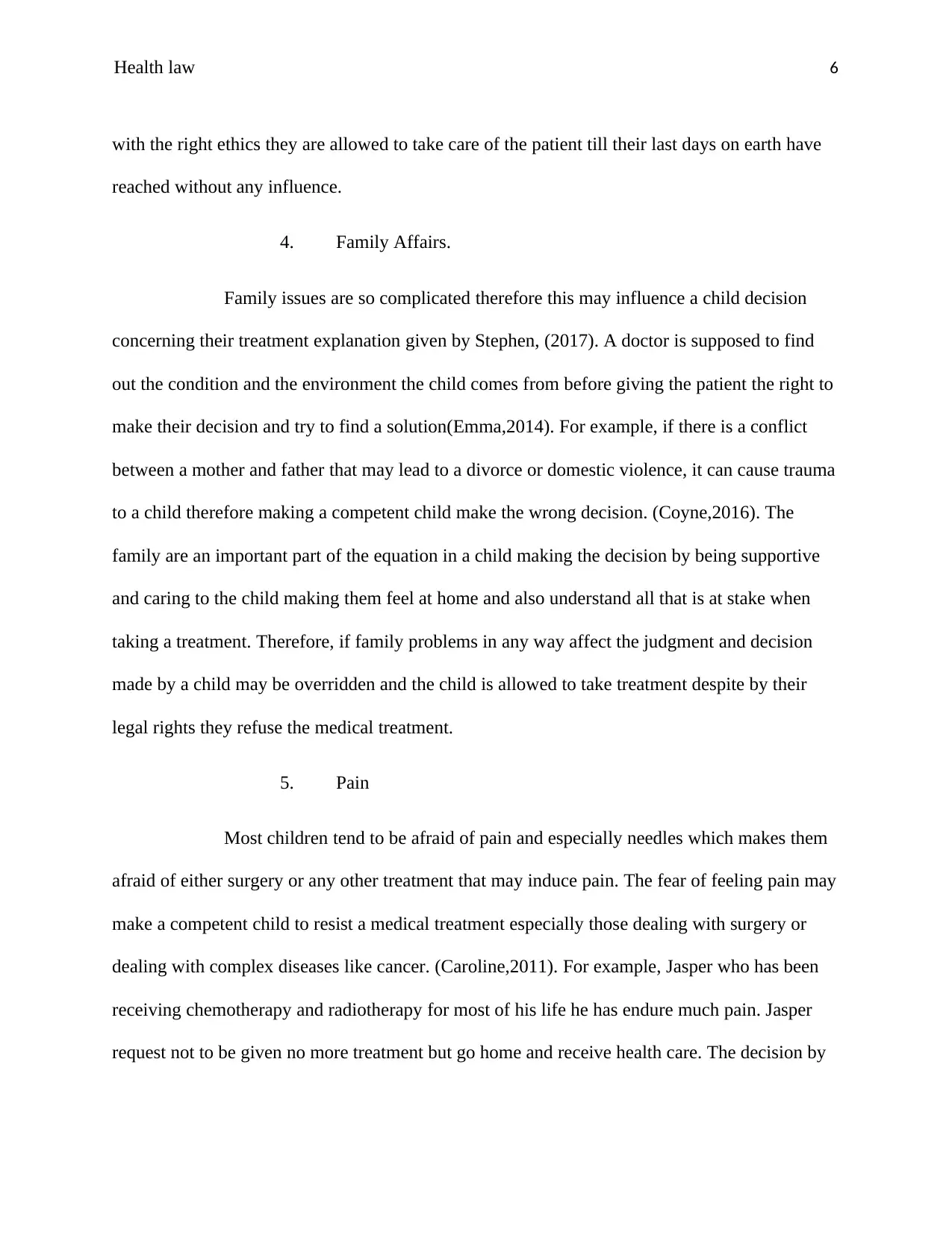
Health law 6
with the right ethics they are allowed to take care of the patient till their last days on earth have
reached without any influence.
4. Family Affairs.
Family issues are so complicated therefore this may influence a child decision
concerning their treatment explanation given by Stephen, (2017). A doctor is supposed to find
out the condition and the environment the child comes from before giving the patient the right to
make their decision and try to find a solution(Emma,2014). For example, if there is a conflict
between a mother and father that may lead to a divorce or domestic violence, it can cause trauma
to a child therefore making a competent child make the wrong decision. (Coyne,2016). The
family are an important part of the equation in a child making the decision by being supportive
and caring to the child making them feel at home and also understand all that is at stake when
taking a treatment. Therefore, if family problems in any way affect the judgment and decision
made by a child may be overridden and the child is allowed to take treatment despite by their
legal rights they refuse the medical treatment.
5. Pain
Most children tend to be afraid of pain and especially needles which makes them
afraid of either surgery or any other treatment that may induce pain. The fear of feeling pain may
make a competent child to resist a medical treatment especially those dealing with surgery or
dealing with complex diseases like cancer. (Caroline,2011). For example, Jasper who has been
receiving chemotherapy and radiotherapy for most of his life he has endure much pain. Jasper
request not to be given no more treatment but go home and receive health care. The decision by
with the right ethics they are allowed to take care of the patient till their last days on earth have
reached without any influence.
4. Family Affairs.
Family issues are so complicated therefore this may influence a child decision
concerning their treatment explanation given by Stephen, (2017). A doctor is supposed to find
out the condition and the environment the child comes from before giving the patient the right to
make their decision and try to find a solution(Emma,2014). For example, if there is a conflict
between a mother and father that may lead to a divorce or domestic violence, it can cause trauma
to a child therefore making a competent child make the wrong decision. (Coyne,2016). The
family are an important part of the equation in a child making the decision by being supportive
and caring to the child making them feel at home and also understand all that is at stake when
taking a treatment. Therefore, if family problems in any way affect the judgment and decision
made by a child may be overridden and the child is allowed to take treatment despite by their
legal rights they refuse the medical treatment.
5. Pain
Most children tend to be afraid of pain and especially needles which makes them
afraid of either surgery or any other treatment that may induce pain. The fear of feeling pain may
make a competent child to resist a medical treatment especially those dealing with surgery or
dealing with complex diseases like cancer. (Caroline,2011). For example, Jasper who has been
receiving chemotherapy and radiotherapy for most of his life he has endure much pain. Jasper
request not to be given no more treatment but go home and receive health care. The decision by
⊘ This is a preview!⊘
Do you want full access?
Subscribe today to unlock all pages.

Trusted by 1+ million students worldwide
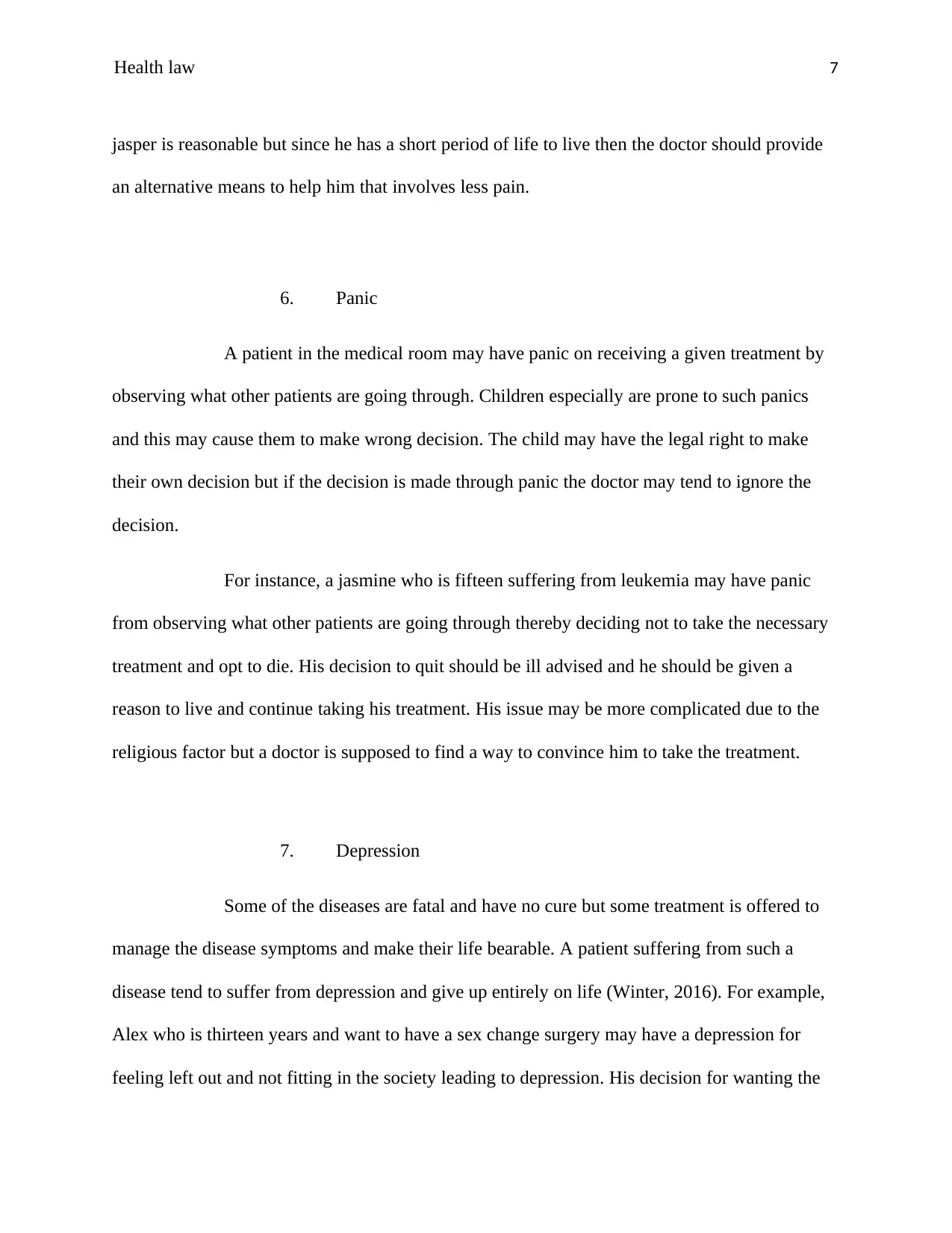
Health law 7
jasper is reasonable but since he has a short period of life to live then the doctor should provide
an alternative means to help him that involves less pain.
6. Panic
A patient in the medical room may have panic on receiving a given treatment by
observing what other patients are going through. Children especially are prone to such panics
and this may cause them to make wrong decision. The child may have the legal right to make
their own decision but if the decision is made through panic the doctor may tend to ignore the
decision.
For instance, a jasmine who is fifteen suffering from leukemia may have panic
from observing what other patients are going through thereby deciding not to take the necessary
treatment and opt to die. His decision to quit should be ill advised and he should be given a
reason to live and continue taking his treatment. His issue may be more complicated due to the
religious factor but a doctor is supposed to find a way to convince him to take the treatment.
7. Depression
Some of the diseases are fatal and have no cure but some treatment is offered to
manage the disease symptoms and make their life bearable. A patient suffering from such a
disease tend to suffer from depression and give up entirely on life (Winter, 2016). For example,
Alex who is thirteen years and want to have a sex change surgery may have a depression for
feeling left out and not fitting in the society leading to depression. His decision for wanting the
jasper is reasonable but since he has a short period of life to live then the doctor should provide
an alternative means to help him that involves less pain.
6. Panic
A patient in the medical room may have panic on receiving a given treatment by
observing what other patients are going through. Children especially are prone to such panics
and this may cause them to make wrong decision. The child may have the legal right to make
their own decision but if the decision is made through panic the doctor may tend to ignore the
decision.
For instance, a jasmine who is fifteen suffering from leukemia may have panic
from observing what other patients are going through thereby deciding not to take the necessary
treatment and opt to die. His decision to quit should be ill advised and he should be given a
reason to live and continue taking his treatment. His issue may be more complicated due to the
religious factor but a doctor is supposed to find a way to convince him to take the treatment.
7. Depression
Some of the diseases are fatal and have no cure but some treatment is offered to
manage the disease symptoms and make their life bearable. A patient suffering from such a
disease tend to suffer from depression and give up entirely on life (Winter, 2016). For example,
Alex who is thirteen years and want to have a sex change surgery may have a depression for
feeling left out and not fitting in the society leading to depression. His decision for wanting the
Paraphrase This Document
Need a fresh take? Get an instant paraphrase of this document with our AI Paraphraser
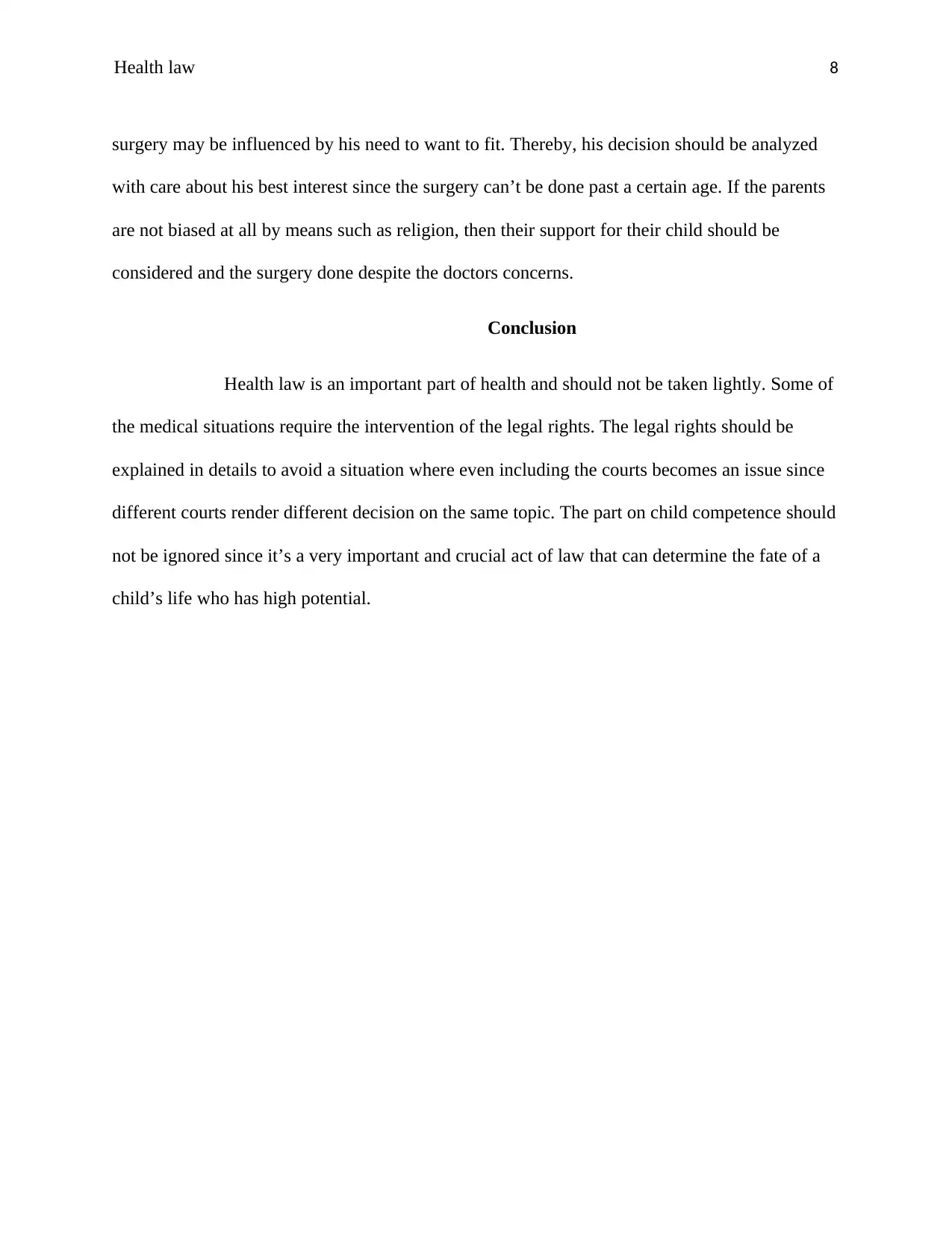
Health law 8
surgery may be influenced by his need to want to fit. Thereby, his decision should be analyzed
with care about his best interest since the surgery can’t be done past a certain age. If the parents
are not biased at all by means such as religion, then their support for their child should be
considered and the surgery done despite the doctors concerns.
Conclusion
Health law is an important part of health and should not be taken lightly. Some of
the medical situations require the intervention of the legal rights. The legal rights should be
explained in details to avoid a situation where even including the courts becomes an issue since
different courts render different decision on the same topic. The part on child competence should
not be ignored since it’s a very important and crucial act of law that can determine the fate of a
child’s life who has high potential.
surgery may be influenced by his need to want to fit. Thereby, his decision should be analyzed
with care about his best interest since the surgery can’t be done past a certain age. If the parents
are not biased at all by means such as religion, then their support for their child should be
considered and the surgery done despite the doctors concerns.
Conclusion
Health law is an important part of health and should not be taken lightly. Some of
the medical situations require the intervention of the legal rights. The legal rights should be
explained in details to avoid a situation where even including the courts becomes an issue since
different courts render different decision on the same topic. The part on child competence should
not be ignored since it’s a very important and crucial act of law that can determine the fate of a
child’s life who has high potential.
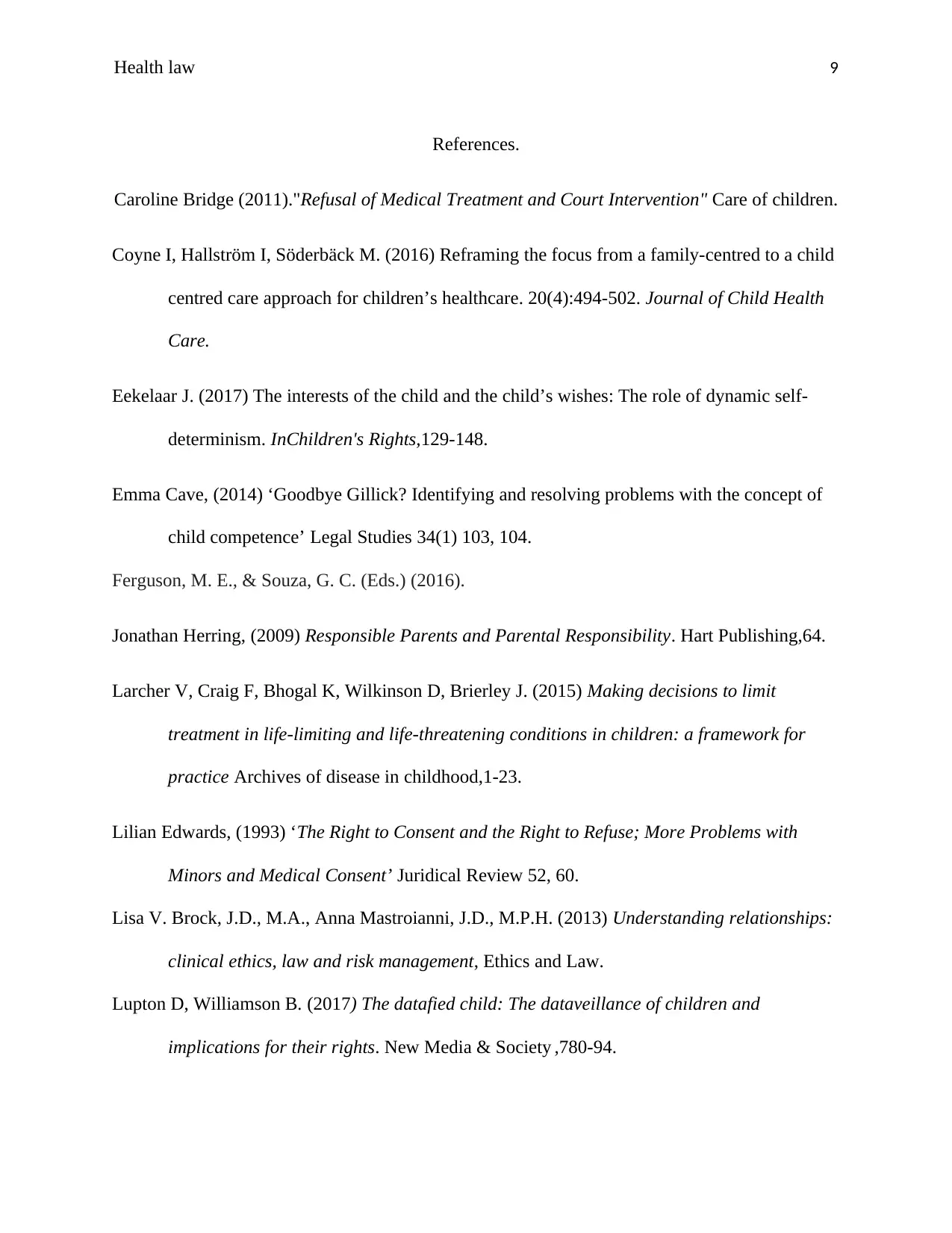
Health law 9
References.
Caroline Bridge (2011)."Refusal of Medical Treatment and Court Intervention" Care of children.
Coyne I, Hallström I, Söderbäck M. (2016) Reframing the focus from a family-centred to a child
centred care approach for children’s healthcare. 20(4):494-502. Journal of Child Health
Care.
Eekelaar J. (2017) The interests of the child and the child’s wishes: The role of dynamic self-
determinism. InChildren's Rights,129-148.
Emma Cave, (2014) ‘Goodbye Gillick? Identifying and resolving problems with the concept of
child competence’ Legal Studies 34(1) 103, 104.
Ferguson, M. E., & Souza, G. C. (Eds.) (2016).
Jonathan Herring, (2009) Responsible Parents and Parental Responsibility. Hart Publishing,64.
Larcher V, Craig F, Bhogal K, Wilkinson D, Brierley J. (2015) Making decisions to limit
treatment in life-limiting and life-threatening conditions in children: a framework for
practice Archives of disease in childhood,1-23.
Lilian Edwards, (1993) ‘The Right to Consent and the Right to Refuse; More Problems with
Minors and Medical Consent’ Juridical Review 52, 60.
Lisa V. Brock, J.D., M.A., Anna Mastroianni, J.D., M.P.H. (2013) Understanding relationships:
clinical ethics, law and risk management, Ethics and Law.
Lupton D, Williamson B. (2017) The datafied child: The dataveillance of children and
implications for their rights. New Media & Society ,780-94.
References.
Caroline Bridge (2011)."Refusal of Medical Treatment and Court Intervention" Care of children.
Coyne I, Hallström I, Söderbäck M. (2016) Reframing the focus from a family-centred to a child
centred care approach for children’s healthcare. 20(4):494-502. Journal of Child Health
Care.
Eekelaar J. (2017) The interests of the child and the child’s wishes: The role of dynamic self-
determinism. InChildren's Rights,129-148.
Emma Cave, (2014) ‘Goodbye Gillick? Identifying and resolving problems with the concept of
child competence’ Legal Studies 34(1) 103, 104.
Ferguson, M. E., & Souza, G. C. (Eds.) (2016).
Jonathan Herring, (2009) Responsible Parents and Parental Responsibility. Hart Publishing,64.
Larcher V, Craig F, Bhogal K, Wilkinson D, Brierley J. (2015) Making decisions to limit
treatment in life-limiting and life-threatening conditions in children: a framework for
practice Archives of disease in childhood,1-23.
Lilian Edwards, (1993) ‘The Right to Consent and the Right to Refuse; More Problems with
Minors and Medical Consent’ Juridical Review 52, 60.
Lisa V. Brock, J.D., M.A., Anna Mastroianni, J.D., M.P.H. (2013) Understanding relationships:
clinical ethics, law and risk management, Ethics and Law.
Lupton D, Williamson B. (2017) The datafied child: The dataveillance of children and
implications for their rights. New Media & Society ,780-94.
⊘ This is a preview!⊘
Do you want full access?
Subscribe today to unlock all pages.

Trusted by 1+ million students worldwide
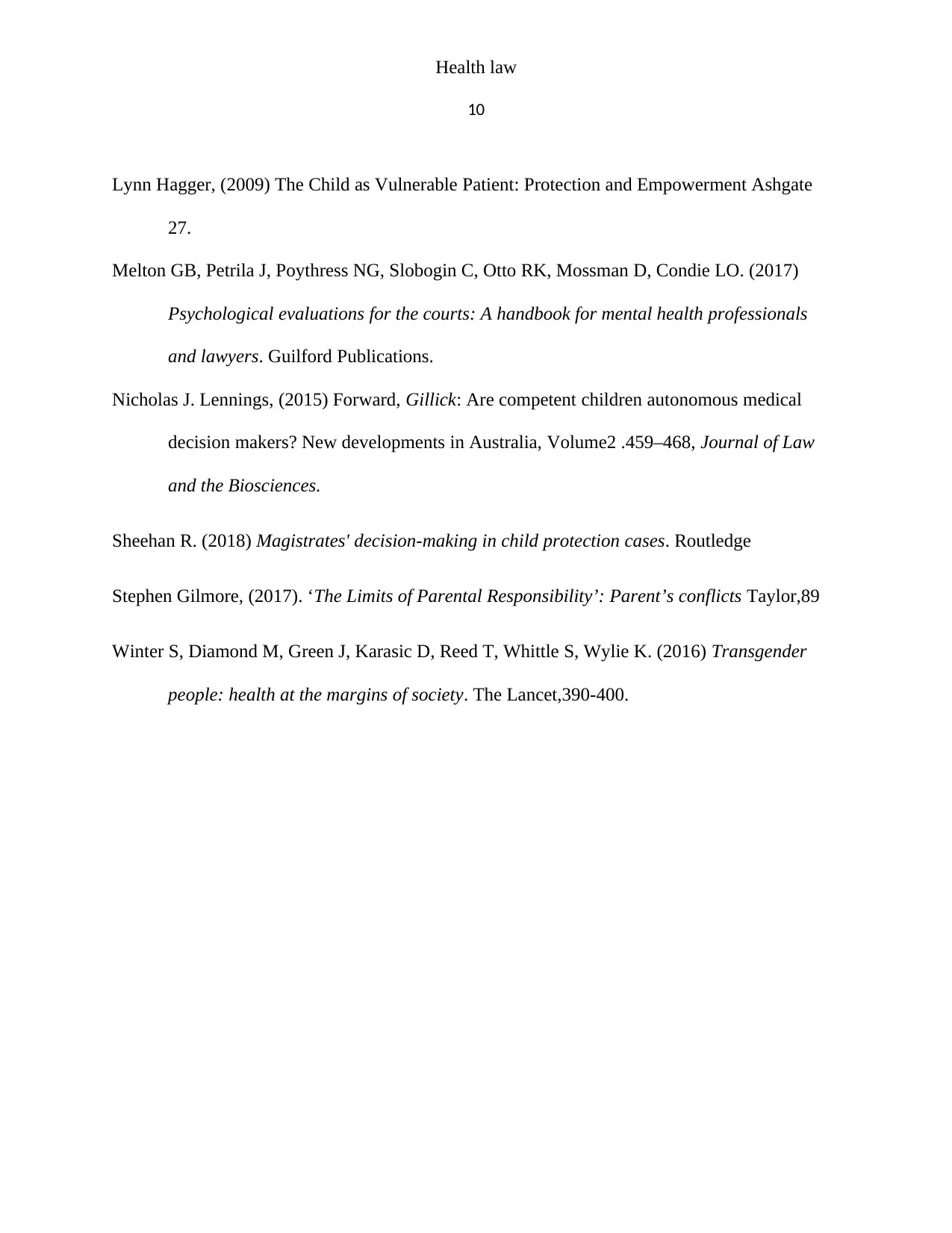
Health law
10
Lynn Hagger, (2009) The Child as Vulnerable Patient: Protection and Empowerment Ashgate
27.
Melton GB, Petrila J, Poythress NG, Slobogin C, Otto RK, Mossman D, Condie LO. (2017)
Psychological evaluations for the courts: A handbook for mental health professionals
and lawyers. Guilford Publications.
Nicholas J. Lennings, (2015) Forward, Gillick: Are competent children autonomous medical
decision makers? New developments in Australia, Volume2 .459–468, Journal of Law
and the Biosciences.
Sheehan R. (2018) Magistrates' decision-making in child protection cases. Routledge
Stephen Gilmore, (2017). ‘The Limits of Parental Responsibility’: Parent’s conflicts Taylor,89
Winter S, Diamond M, Green J, Karasic D, Reed T, Whittle S, Wylie K. (2016) Transgender
people: health at the margins of society. The Lancet,390-400.
10
Lynn Hagger, (2009) The Child as Vulnerable Patient: Protection and Empowerment Ashgate
27.
Melton GB, Petrila J, Poythress NG, Slobogin C, Otto RK, Mossman D, Condie LO. (2017)
Psychological evaluations for the courts: A handbook for mental health professionals
and lawyers. Guilford Publications.
Nicholas J. Lennings, (2015) Forward, Gillick: Are competent children autonomous medical
decision makers? New developments in Australia, Volume2 .459–468, Journal of Law
and the Biosciences.
Sheehan R. (2018) Magistrates' decision-making in child protection cases. Routledge
Stephen Gilmore, (2017). ‘The Limits of Parental Responsibility’: Parent’s conflicts Taylor,89
Winter S, Diamond M, Green J, Karasic D, Reed T, Whittle S, Wylie K. (2016) Transgender
people: health at the margins of society. The Lancet,390-400.
1 out of 10
Related Documents
Your All-in-One AI-Powered Toolkit for Academic Success.
+13062052269
info@desklib.com
Available 24*7 on WhatsApp / Email
![[object Object]](/_next/static/media/star-bottom.7253800d.svg)
Unlock your academic potential
Copyright © 2020–2025 A2Z Services. All Rights Reserved. Developed and managed by ZUCOL.





